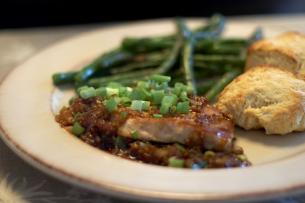
By now, startcooking.com subscribers are mastering some basic techniques and recipes. You’ve learned how to make omelets with cheese,
meatloaf and maybe even grilled chicken. But what else are you putting on your plate?
If you’re new to cooking, you might be uncertain about how to balance meals and figure out appropriate portions. It’s difficult to get a handle on what a healthy meal should look like when restaurants are serving mountains of food and then asking if we’d like fries with that. (Hey, who wouldn’t?)
It’s actually very easy to figure out if your meal is balanced: just use your plate as your guide. Ideally, that meatloaf (or other protein serving) should take up about a quarter of the space on your plate, carbohydrates (bread, rice, pasta, etc.) can take up another quarter, and vegetables should fill the other half.
Portion control plates, which have markers dividing the plate into different food groups, have been shown to help people control their weight. They provide an in-your-face reminder of proper portion sizes at each meal. There’s no weighing, measuring or calorie counting to worry about.
Another strategy for keeping meals on track is to switch from using a dinner plate to a smaller salad plate. If you want to eat seconds, just load up on more vegetables.
There are other ways to get a good idea of appropriate portion sizes. Check out the food gallery at the US Department of Agriculture website. It shows, for example, what half a cup of oatmeal – that’s a serving of carbohydrates – looks like in a six-inch bowl.
It’s also helpful to keep in mind the following visuals:
- One 3- to 4-ounce protein serving is about the size of a deck of cards
- A one-cup serving of pasta or rice is about the size of a baseball
- A one-ounce serving of cheese is roughly the size of a thumb
Despite our best intentions, sometimes life gets in the way and it’s not always possible to eat balanced meals. To get some perspective on how a busy person integrates healthy eating into her life, check out the blog Eat Like Me. Registered dietitian Christin Dillon chronicles her daily meals and snacks, photographing them so that you can see exactly what and how much she’s eating. You’ll see that – gasp! – even a dietitian enjoys foods like muffins and popsicle as part of a healthy diet.
More adventurous cooks might find that Bento box-style eating helps control portions. There are tons of ideas for creating homemade lunches for Bento boxes over at the site Just Bento. Bento boxes are compartmentalized meal containers that are traditionally used in Japan. The blog’s author says Bento-style eating helps her maintain a balanced diet and healthy weight. Her mouthwatering photos of bento lunches are certainly persuasive!
If you are new to startcooking, or are a regular visitor here, please consider subscribing for free.








































Andy said:
Great advice! My portions are usually heavy on the protein, so I am trying to lessen that and eat more vegetables and things. I think the problem is that if I am making some sort of meat, I usually look at it as the main course, whereas I need to see it as a small part and make other side dishes to fill me up.
The great thing is, when I do make a smaller portion of meat, I don’t feel like I am missing anything.